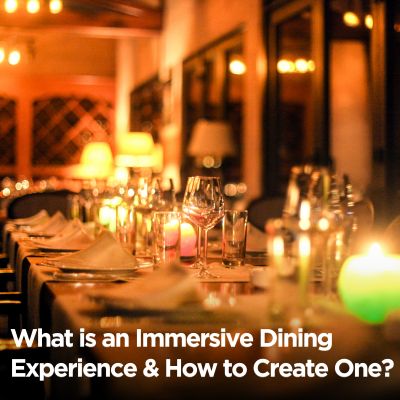An immersive dining experience turns a simple meal into something unforgettable. It’s more than just good food—it’s about creating a setting that engages all five senses.
Whether through interactive visuals, themed environments, ambient sounds, or even scents that complement the dishes, immersive dining makes guests feel like they’ve entered a different world.
Restaurants are using this concept to offer something beyond the usual dining experience. Thoughtfully designed lighting, projection mapping, and sensory elements like temperature changes or custom scents can enhance the atmosphere.
This approach makes dining more enjoyable and encourages guests to return, share their experience, and recommend it to others.
What is an Immersive Dining Experience?
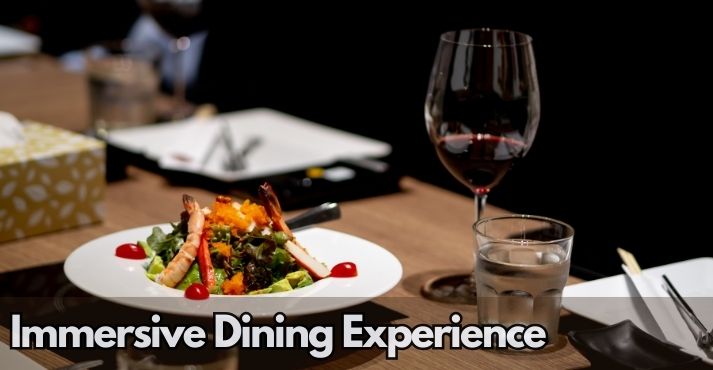
An immersive dining experience combines food with interactive and sensory elements, making a meal far more engaging than traditional dining.
It’s not just about taste—it’s about creating an environment where visuals, sounds, textures, and even scents enhance the experience.
From themed settings to technology-driven effects, immersive dining transports guests into a curated world where every detail complements the food.
Diners today are actively looking for unique experiences, and they’re willing to pay more for them. According to Eventbrite, 75% of diners are open to spending extra on a one-of-a-kind meal.
This growing demand makes immersive dining a powerful way for restaurants to stand out while delivering something special.
Key Components
Creating an immersive restaurant experience requires a combination of carefully curated elements. The right mix of sensory engagement, interactive participation, and technology can change a simple meal into an unforgettable journey.
1. Sensory Engagement
A successful immersive dining experience stimulates multiple senses at once. Restaurants use visual storytelling, music, scents, and touch to enhance the atmosphere.
Projection mapping can turn walls into dynamic scenes, while themed music changes throughout the meal to enhance the experience. Some restaurants infuse scents into the air to complement the dish, making the flavors even more pronounced.
Even textures, such as handcrafted ceramic plates or velvet-covered seating, add depth to the experience.
Restaurants create an emotional connection with guests by creating an intentional environment. This multisensory approach turns a meal into something people want to share and talk about long after they’ve left the table.
2. Interactive Participation
Immersive dining encourages guests to become active participants rather than just passive diners. This can range from interactive storytelling to hands-on experiences, such as:
- Live performances: Actors, dancers, or themed characters interact with guests throughout the meal.
- Personalized elements: Guests might receive custom menus or be invited to select ingredients for their dishes.
- Augmented reality (AR) menus: Some restaurants use AR apps to bring digital elements into the experience, such as 3D visualizations of dishes before they arrive.
By involving guests in the experience, restaurants create a deeper connection between the diner and the meal, making it far more memorable than a traditional night out.
Examples of Immersive Dining
Restaurants worldwide are experimenting with different ways to elevate dining into a multi-sensory experience. Whether through elaborate decor, technology, or interactive storytelling, these concepts redefine how people engage with food.
1. Themed Environments
A themed dining experience immerses guests in another time, place, or fantasy world. Some restaurants recreate historical settings, while others build futuristic or whimsical worlds. Examples include:
- Jungle-or-ocean-themed restaurants where diners feel surrounded by nature.
- Historical or cultural themes include a 1920s speakeasy with jazz music and vintage decor.
- Fantasy-inspired dining, where guests feel like they’ve entered a movie or storybook setting.
Fantasy-inspired dining, like The Alice in Wonderland Cocktail Experience, brings stories to life. At this interactive pop-up bar, guests sip themed drinks while immersed in a theatrical world inspired by Lewis Carroll’s classic tale.
A survey found that 76% of diners look for a memorable location, 84% are drawn to a surprising menu or theme, and 74% seek a truly unique experience. Thoughtfully designed environments tap into these desires, making meals feel magical.
2. Technology Integration
Advancements in technology in restaurants have opened up new possibilities for immersive dining experiences. Some of the most exciting innovations include:
- Projection mapping: Bringing tabletops or entire rooms to life with animated visuals, creating dynamic, ever-changing environments.
- Augmented reality (AR) dining: Using AR apps to bring menus or storytelling elements to life, adding an interactive layer to the meal.
- Virtual reality (VR) dining: Allowing guests to explore entirely new worlds through VR headsets while they eat.
- Holographic displays: Introducing 3D visuals into the dining space for a futuristic and visually stunning experience.
These technologies enhance themed dining by enhancing storytelling, engagement, and ambiance. Meals become more than just food—they become unforgettable experiences.
An example is Ultraviolet by Paul Pairet in Shanghai, a high-tech restaurant that turns dining into a multi-sensory journey. Using 360-degree projections, sound effects, and scent diffusion, each course comes with a changing atmosphere.
For one dish, guests might feel like they’re in a rainforest, while the next might be in a busy city. This combination of technology and food creates a one-of-a-kind immersive restaurant experience that engages all the senses.
Benefits of Offering an Immersive Dining Experience
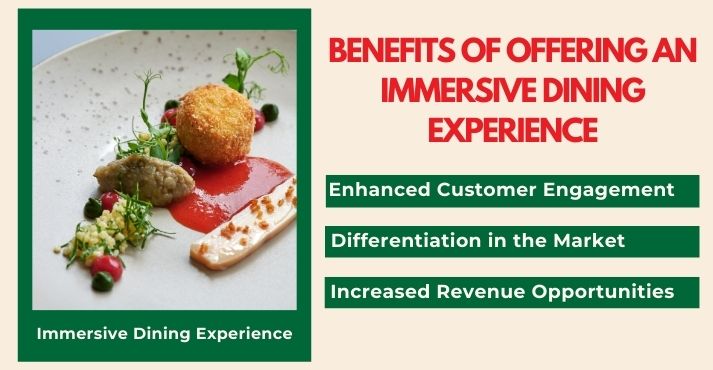
An immersive dining experience goes beyond great food—it turns a meal into an unforgettable event. By combining ambiance, storytelling, and interactive dining experiences, restaurants can captivate guests and keep them returning for more.
Offering an experiential dining concept through themed settings, cutting-edge technology, or sensory elements helps establish a memorable destination that stands out in a competitive market.
Enhanced Customer Engagement
Guests are more likely to return when dining becomes an experience rather than just a meal. Themed decor, storytelling elements, and high-quality tableware help create a memorable atmosphere that encourages repeat visits and word-of-mouth recommendations.
Interactive elements, such as projection mapping or tableside performances, keep diners engaged and make the experience more shareable on social media, increasing visibility.
Restaurants that successfully create emotional connections with guests build stronger brand loyalty, turning one-time visitors into regular patrons.
Differentiation in the Market
With growing trends in hospitality, restaurants must stand out in a crowded industry. Offering an interactive dining experience allows restaurants to carve out a niche and attract diners looking for something beyond the usual.
By incorporating themed environments, multi-sensory elements, or cutting-edge technology, restaurants can position themselves as must-visit destinations.
This differentiation helps attract new customers and strengthens the brand’s reputation in the industry. As competition increases, restaurants that provide immersive experiences will likely stay ahead of the curve.
Increased Revenue Opportunities
Customers are willing to pay more for a one-of-a-kind experience. Hotels that offer unique dining experiences see a 10% increase in F&B revenue compared to those that don’t.
By incorporating immersive elements, restaurants can attract premium diners, host special events, and create exclusive menu offerings that drive higher sales.
Special themed nights, chef’s table experiences, or limited-time immersive menus can justify higher pricing while keeping customers excited about new offerings.
Additionally, immersive dining creates opportunities for upselling, such as pairing meals with themed cocktails, merchandise, or exclusive VIP seating options.
How to Create an Immersive Dining Experience
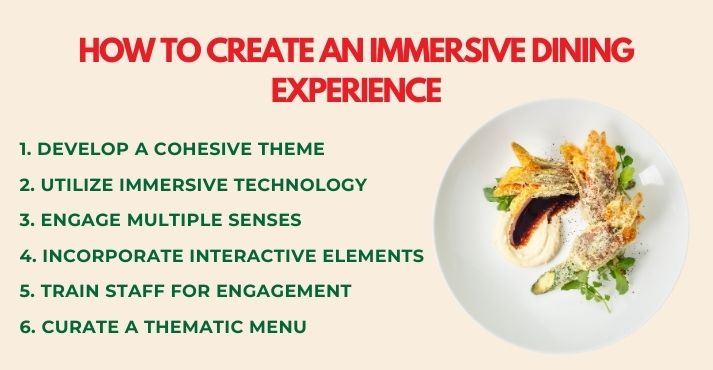
An immersive dining experience is about designing an atmosphere that captivates guests, engages their senses, and brings a concept to life. From technology-driven enhancements to sensory engagement, every detail makes a meal feel like an adventure.
When done right, this approach can improve restaurant operations by increasing customer satisfaction and encouraging repeat visits.
1. Develop a Cohesive Theme
Selecting a strong theme sets the foundation for an immersive food experience. Whether it’s a retro 1920s speakeasy, a futuristic sci-fi setting, or a nature-inspired retreat, the theme should align with the restaurant’s brand and resonate with its target audience.
Every aspect, including decor, menu design, and staff interactions, should reinforce the theme to ensure consistency and complete immersion.
2. Utilize Immersive Technology
Technology can turn a dining space into an interactive environment. Projection mapping can bring tabletops and walls to life with dynamic visuals, while AR and VR can add digital layers of storytelling.
Holographic displays and interactive digital menus enhance engagement, making meals feel more than just dining—they become entertainment.
3. Engage Multiple Senses
A truly immersive food experience stimulates more than just taste.
- Lighting and decor set the mood and enhance the atmosphere.
- Music and ambient sounds complement the theme, creating an auditory experience.
- Signature scents can transport guests to a different place, reinforcing the environment.
- Textures in decor and high-quality tableware add another layer of engagement.
Studies show that 63% of consumers seek dining experiences that engage multiple senses, making sensory engagement a powerful way to enhance guest satisfaction.
4. Incorporate Interactive Elements
Encouraging guests to participate adds excitement to the experience. Live performers, such as actors, musicians, or themed entertainers, can interact with diners, deepening their connection to the setting.
Some restaurants offer hands-on experiences, such as tableside cooking, mixology sessions, or interactive storytelling, that allow guests to engage beyond eating.
5. Train Staff for Immersive Engagement
Staff is important in maintaining immersion. Training them to adopt character personas or specific roles that align with the restaurant’s theme can enhance the experience.
For example, a medieval-themed restaurant may have servers dressed as knights and wenches, while a futuristic dining concept could feature staff interacting with guests as AI assistants. Encouraging engaging interactions helps reinforce the storytelling aspect.
6. Curate a Thematic Menu
A well-designed menu ties the entire dining experience together. Dishes and drinks should reflect the chosen theme, using ingredients and presentation styles that enhance authenticity.
Themed plating, custom cocktails, and different food pairings can further transport guests. Storytelling can also be incorporated into the meal, where each course is introduced with a narrative that adds context and intrigue.
Challenges and Considerations
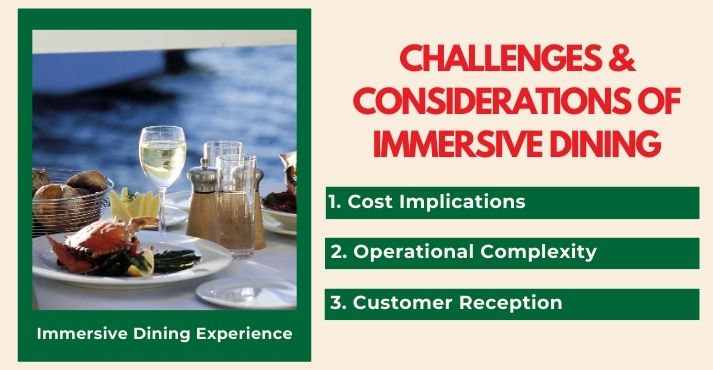
While an immersive dining experience can enhance a restaurant, it comes with challenges that require careful planning. From financial investment to operational adjustments, restaurants must weigh the benefits against potential hurdles.
1. Cost Implications
Implementing immersive elements, such as advanced technology, themed decor, and interactive components, can require a significant upfront investment.
High-quality tableware, projection mapping, and sensory enhancements all contribute to costs. However, these investments can lead to long-term profitability with the right strategy.
2. Operational Complexity
Running a dining concept involves more than just serving food—it requires well-coordinated efforts across staff, technology, and logistics.
Employees may need specialized training to maintain the experience, and seamless execution is crucial to avoid disruptions. Proper planning can help improve restaurant operations and ensure smooth service.
3. Customer Reception
Not all guests may be drawn to an experiential dining concept, making market research essential. Understanding the target audience’s preferences helps create an experience that resonates rather than overwhelms.
Diners are increasingly seeking engaging experiences, but it’s important to maintain a balance that appeals to a wide audience.
Conclusion
An immersive dining experience captivates guests, creates lasting memories, and helps restaurants stand out.
By engaging multiple senses, incorporating interactive elements, and using innovative technology, dining becomes more than just a meal—it becomes an experience that guests remember.
Experiential dining concepts offer exciting possibilities for restaurateurs looking to enhance customer satisfaction and attract new diners. With thoughtful planning and creativity, restaurants can create an environment that keeps guests engaged and returning for more.

